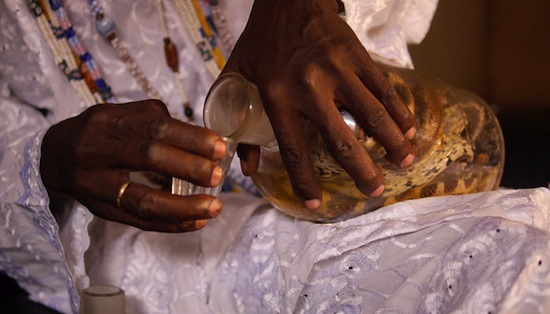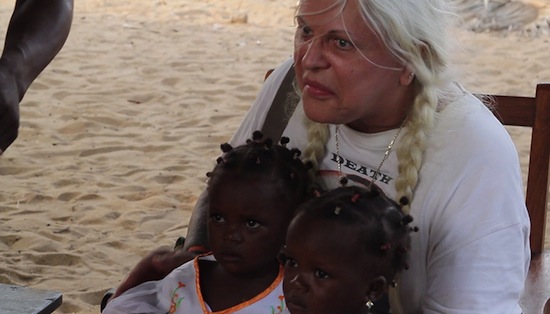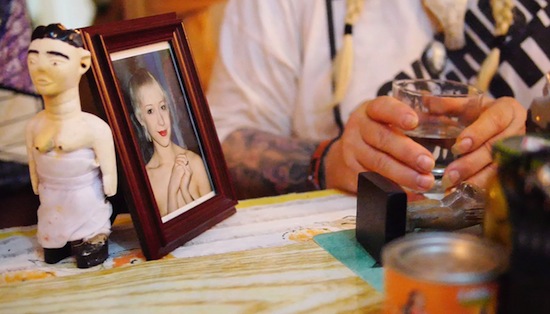Last December, Genesis Breyer P-Orridge and Los Angeles-based artist and film-maker Hazel Hill McCarthy III visited Ouidah in Benin to make a documentary exploring the origins of the religion Vodun. While there, P-Orridge was initiated into the Twin Fetish, a Vodun practice that celebrates twins – particularly resonant in Benin, which has the highest national average of twins per birth and where they carry a sacred meaning – honouring her relationship with h/er late wife and pandrogyne partner Lady Jaye Breyer P-Orridge. As McCarthy writes of the film: "In this story we begin to see the link between pandrogyny and the Twin Fetish, an activation of a complete state and in fact the true fundamentals of Vodun religion." Have a watch of the trailer above.
McCarthy has now started a Kickstarter project to fund the completion of Bight Of The Twin by returning to the country in September for the annual Twin Ceremonies for West African twins. The project is aiming to reach a target of $18,000, with rewards for backers ranging from original stills from the film and Thee Psychick Bible: A New Testameant books and DVDs all the way to executive producer credits and a West African Boubou/Bubu dress or suit made by the official tailor of the heads of Vodun – head to their Kickstarter page for full details and to make a pledge. We talked to McCarthy over e-mail to find out more about the film.
Can you tell us a little about your history and past work with Genesis P-Orridge?
Hazel Hill McCarthy III: I started working with Genesis in 2008, designing Thee Psychick Bible and archiving Psychic TV and Temple ov Psychick Youth videos for what became the accompanying DVD. Genesis and I worked almost exclusively in the Brooklyn apartment that s/he had shared with Lady Jaye, which was an extremely enlightening and warm experience. At the time I had my own project space in Los Angeles called Show Cave, creating content and curating a series of touring video shows, specifically Licker License and Gentle Jousting, that dealt with perceptions of gender. Since then Genesis and I have collaborated on a number of projects, such as Weird Woman, XXX Sigil and transFormation, the latter being part of Genesis’ retrospective at the Warhol Museum.
How did the inspiration for this project come about?
HHM III: In 2011 Gen and myself travelled to Kathmandu for a kind of spiritual retreat. I happen to read a piece in The Guardian about the annual Voodoo festival in Ouidah, Benin, and immediately became fascinated by the spectacle and performance, pageantry and beauty of the costumes adorned by the priests and spirits. Then, among my discovering the grandeur of this mountainous foreign land, things started to unravel in Nepal. Genesis was rushed to hospital after suffering a severe gall bladder infection and was in a critical condition. Sitting by h/er side in hospital, in desperation, I told her, "If you make it out of here alive, we will travel to Ouidah, Benin for the annual voodoo festival to find our parallel selves." S/he agreed and, thankfully, recovered remarkably quickly. True to h/er word, we set the date for the December after h/er retrospective at the Warhol Museum.
Given the twin ceremony and the memory of Lady Jaye, was it a very emotional project with which to get involved?
HHM III: Upon our arrival in Africa late into a hot, sticky sub-Saharan night we began a steep learning curve about what type of situation we had readily put ourselves in. The initiation and the ceremony happened very quickly, actually on the evening of just day two of being in Ouidah. The chaotic allure of the town and the people really gave little time to stop and reflect in any significant way, but we all felt the depth of Gen’s emotions. The fact there is a ceremonial aspect to twinning that is for anyone losing their other half, their twin, and it is meant to give an overt representation, an acknowledgement of loss really resonated with Gen’s circumstances after Lady Jaye’s death. For Genesis it was something that was meant to be, an awakening of how to grieve, how to bring Jaye home. Poetically, s/he now walks again with h/er twin in NY.
How did you go about researching the film? Were you conscious of not fetishising the traditions and ceremonies?
HHM III: A lot of the film is really about an attempt to immerse fully into a culture though there has, of course, been research. Professors Suzanne Preston Blier at Harvard University and Darcy Greene at Michigan State University have been greatly influential in contextualising Vodun art and culture. I’ve also been assisted by the work of Professor Christiaan Monden at Oxford University and his research following the West African phenomenon of twins and its uncanny abundance in numbers per birth, although we were unfamiliar with any specific twin fetish before we went to film. It truly was a serendipitous moment to be involved with the priests and adept of the Twin Fetish. Our goal is to return to the annual Twin Ceremonies at the end of September for the living and the dead twins. This is where the twins of West Africa come together in Ouidah to celebrate.

How did the people in Benin react to you and the film?
HHM III: From the get-go we were well received but certainly after Genesis was initiated into the Twin Fetish, everyone interacted with h/er and the small film crew with enormous warmth. There was an unspoken acceptance that came in the form of a little wooden statue, the twin. In fact, other twins freely came to interact with Genesis and h/er twin. Of course there was an awareness of the filming, which is regularly restricted until a cash payment is extracted, but the longer we stayed seen with the Vodun chiefs the easier it got. That said, we had to continue being conscious of what was acceptable to film and what was a disrespectful overview of Beninese culture. For example, the abundant bocio (empowered objects) are very special. They are energised with intentions and purpose. To film them without any context or purpose would have been a direct discourtesy.
I know in the film Gen says it ended up not as expected… can you talk about that now, or will that be revealed in the film?
HHM III: It is a developing story. We went to document the annual Voodoo festival and the people who partake in its endeavours. With Genesis by my side we were to ask questions and soak in what we learned. My feeling is that the outsiders, the alternative, the counter culture, or whatever you want to describe it as, is the natural human state. The rawness of Vodun is the most pure form of art, life and existence. As artists we have a need to find and explore ideas of activation and purpose. So what started as a benign look at Voodoo and Western culture became an intense, intimate participation in the practice of Vodun Twin Fetish and we found that Vodun is truly a religion of kindness and love. The film explores this love and kindness, bringing to light the beauty of Vodun with a hope of dispelling common misconceptions of it as a dark and ominous religion.

What will the Kickstarter project fund?
HHM III: The Kickstarter will fund the production to return to Ouidah for the Twin Ceremonies. This will complete Genesis’ pilgrimage with her twin and complete the story of the film. I will be returning to Africa, accompanied by Cyrusrex and my husband, Douglas J. McCarthy. They will be writing and recording the film’s soundtrack on location using modular synths and effects with Genesis also writing and performing vocals – everyone drawing deeply from the environment.
Trailer credits: Genesis Breyer P-Orridge, Dah Gbedjinon, Adepts, Drew Denny, Douglas J. McCarthy, Lewis Teague Wright, Eric Nordhauser, Hypolite Apovo and Emmanuel Sardou Gbedjinon.
Tracks by COUM Transmissions, DJMREX and Atem Hein


